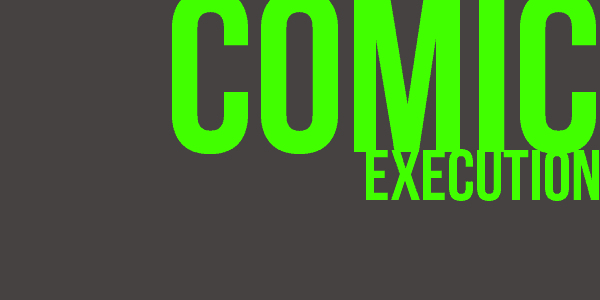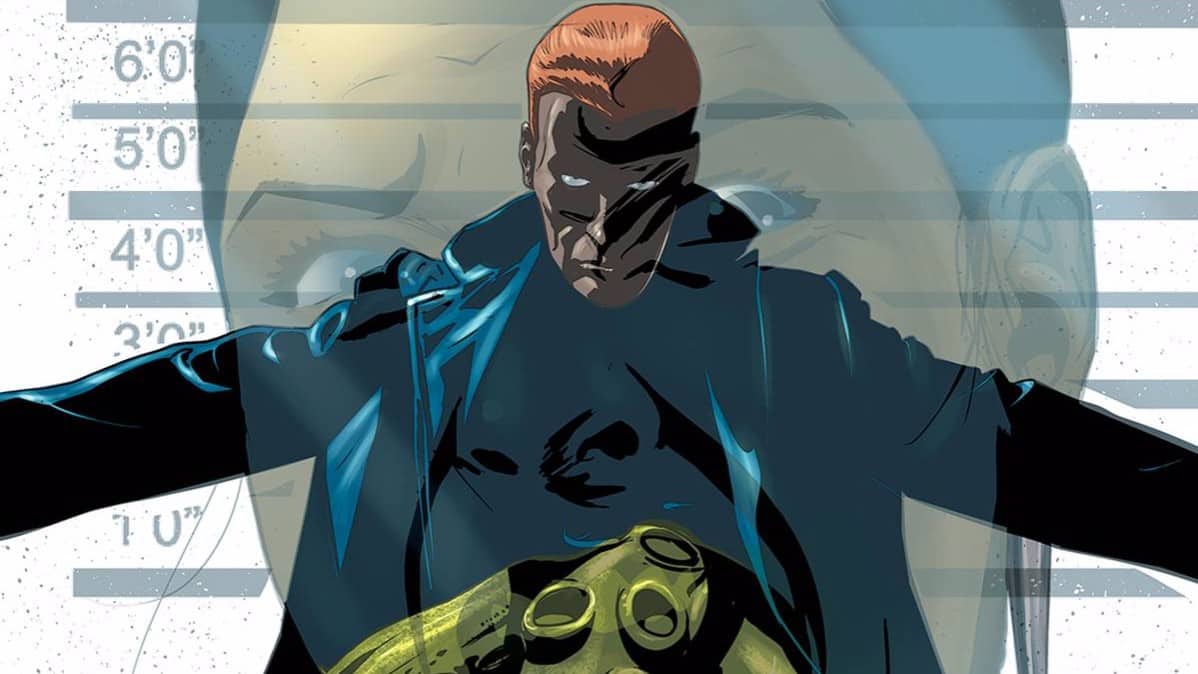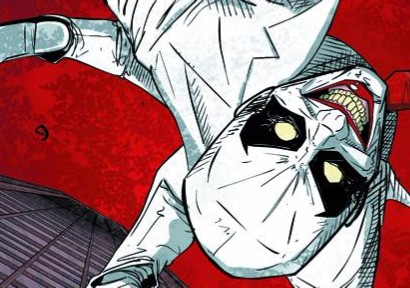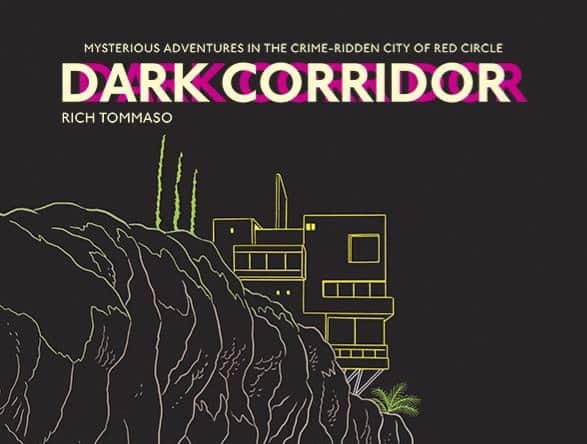
[Comic Execution] 10/3 – ALIENS, JUSTICE INC, AND THEN EMILY WAS GONE
This site is gonna be changing soon, getting a whole new look. It’s a big deal, as it hasn’t done so since I first started reading it two years ago, probably more than that though. But Comic Execution won’t change. I like this format too much. While I’d certainly like to expand my coverage of comics at Destroy The Brain, I think we’re lacking in general coverage as is, so until we have a bit more in the way of contributors, don’t expect much else besides the column and the occasional interview. I’d love to offer things like previews or contests but it’s proving difficult to get publishers to play ball. I really wanted to do a feature on the Alien/Prometheus/Predator crossover but Dark Horse never responded so instead I’m just doing basic reviews. Which is kind of nice because I don’t have to be scared to tear their comics apart, as you may have noticed from last week’s reviews. Not that I’d be scared if they DID offer me exclusives or interviews. That’s just not me. I think.
ALIENS: FIRE & STONE #1
Writer: Chris Roberson
Artist: Patric Reynolds
Colorist: Dave Stewart
Publisher: Dark Horse Comics
Price: $4 (Digital)
Here we are at the launch of the second installment of Fire & Stone, Dark Horse Comics’ attempt to reinvigorate the comic book franchise spinoff of the shared Alien/Predator universe they established in the late eighties. It’s telling that we started off with Prometheus and now are seeing the part of the story that revolves around the xenomorphs, as many consider the Predator an anomalous facet of this universe and I’m sure Dark Horse wouldn’t want to slow the potential momentum Prometheus kicked off by interrupting it with a lesser loved subject. In fact, the title focusing strictly on the Predator story is the last of the series to debut, even behind the notoriously iffy Alien Vs Predator property. Certainly not a vote of confidence, assuming all of these books were on the same time frame (which they were, as the entire web of continuity was created in a single room between all the responsible creators). That kind of cynicism doesn’t bode well for the series, even if it’s justified by the lackluster reception of Predators compared to Prometheus (though these are comics, which have a very different audience than movies).
Right off the bat there’s disappointment as the xenomorphs are in full force, panel one. Alien was a successful film because it took the violent intensity of slasher films into space, where it didn’t belong at the time. The sequel worked because it balanced the suspenseful, shocking fright with further exploration of the Alien universe. By throwing the xenomorphs right in our face from the start, writer Chris Roberson completely disarms them. Instead, we’re left to follow the plight of the survivors of their attacks. Fortunately, Roberson writes fully-formed, relatable yet memorable characters, led by a particularly atypical protagonist; one of the engineers becomes the defacto leader, using his wits and hidden strength to save as many lives as he can. Roberson does manage to restore some semblance of tension by organically rebooting the alien threat, transplanting the conflict to a familiar (to the readers) locale. In this way, the overconfident, well-equipped cast of Prometheus is contrasted, Roberson miring his characters in dire straits from the start which invests me better in their survival.
Patric Reynolds is responsible for the art of this issue and really, it doesn’t get much more high pressure than illustrating the high profile reboot of Alien. Whether by choice, his first page sets the bar for the rest of the book, as a grungy panel full of alien on human carnage takes up most of the page. The problem is that it’s impossible to tell how much work Reynolds is putting into his lines because colorist Dave Stewart smothers them all in drastic, shadow-carpeted blurriness. Comparing the original lineart Reynolds has posted online to the finished product, it’s actually impressive how Stewart destroys the violent, stark intensity by slathering it in bland, haphazard variations on brown. It doesn’t help that Reynolds makes all his backgrounds look the same, which could be excused by the industrial setting except the set design for Alien was intended to evoke claustrophobia and anxiety, not boredom. It’s really a startling drop in art quality from Prometheus to this and the impact of the story is lessened as a result.
As I expected, by stretching their resources too thin, the creative forces behind Fire & Stone have made compromises from book to book. Prometheus has great art but an uninteresting story that simply repeated the movie, while Aliens actually has solid writing but lacks the artistic energy to execute it. Likely we’ll see the same problems with the AvP and Predator titles. But as a writer myself, I’m of the opinion that a good story can elevate mediocre art into something worthwhile and with the change of scenery and reduction of the conflict to something more personal, I’m optimistic that the next issue of Alien: Fire & Stone will see the story and art synchronize properly.
Writer: John Lees
Artist: Iain Laurie
Colorist: Megan Wilson
Publisher: Comix Tribe
Price: $3 (Digital)
Let’s get the technical bits of this review out of the way before I get to what I really want to talk about with this, the third issue of And Then Emily Was Gone. The writing is on point this issue, surprising immediately by refusing to surrender the suspense of last issue’s cliffhanger, instead amplifies it even further before the predictable reveal of wrongly presumed malevolence. This new, benevolent character serves as the first substantial source of exposition in the series, something it didn’t necessarily need but has been so well laid out that it feels organic rather than deliberate. Hellinger’s angry refusal to accept Fiona’s fervent belief in a supernatural cause behind Emily’s disappearance is a bit abrupt but I think it could be tied to Carey’s meddling and what he sees as misleading Fiona. The dream sequence is… well, I can’t say anything about it specifically, just that when it’s over, you’re going to be at least a little concerned about the mental well being of writer John Lees. The book ends by sort of tying at least two of the disparate threads together, so we know that it’s beginning to come together, even as the characters themselves are starting to fall apart.
Iain Laurie really steps up the game, artistically, with this issue. There’s so many panels that are simple yet brimming with strange energy; an oversized hand offering a knife to Fiona makes the knife seem small and alien, enhancing its otherworldliness, augmented by the grotesque anatomy of the hand itself and the abstract pattern of the knife handle. At the same time, he humanizes Big Carey, despite an inhuman appearance, with little touches to his expressions. At the other end of the spectrum, the nightmare fox is laced with dreadful detail, like his coarse-looking fur and elongated, devilish ears. If that whole scene doesn’t give you the chills, you’re more jaded than me. Megan Wilson keeps the colors subtle and moody throughout the first half but goes full bore during the dream sequence, sometimes slathering a panel in ominous black shadows or using that same inky black to bring to life the awful vines and mutated monsters pretending to be memories. There’s a lot of rusty colors and more than a few splashes of crimson that give key moments a heightened intensity. If Lees is the songwriter then Laurie is playing the melody and Wilson the rhythm, adding their own distinctive style to the coherent whole.
So, now that we’re done with that, let’s talk about context. In my last issue, I claimed that And Then Emily Was Gone read like Ben Wheatley (Kill List, A Field In England) adapting a Stephen King novel. This issue feels much closer to the style of David Lynch but has so much more going on. Take the nightmare fox; this evokes Donnie Darko pretty strongly, especially at the climax of the dream sequence. There’s something of Jacob’s Ladder to the sudden transformation of normal humans into exaggerated freaks in the dream and the big reveal of Emma echoes the discovery of Norman Bates’ skeletal secret in Psycho. And the presence of the unnatural vines wouldn’t seem out of place in a Quay Brothers film. But Lees and Laurie aren’t imitating anyone; this whole issue is frighteningly authentic. They summon their nightmare whole and authentically. The core of this is Bonnie Shaw, a bizarre boogeyman who ties the whole thing together, a unique malevolence that could never be replicated in a different medium. Usually, showing and naming the evil takes its power away but Bonnie Shaw has such a raw, surreal menace that looking at it on the page for too long makes me nervous. Mainly because its just an imagined thing in the comic and, as an imagined thing, it only exists because you believe it does… which has some frightening implications beyond the page.
With issue three, And Then Emily Was Gone passes into the annals of horror comics that have not only survived my judgement but have gotten better with the passing of each iteration. And the creators promise me that the fourth will be when it becomes true horror. If you’re a fan of horror at all, you need to read this comic. Period.
 JUSTICE INC #2
JUSTICE INC #2
Writer: Michael Uslan
Artist: Giovanni Timpano
Colorist: Marco Lesko
Publisher: Dynamite Entertainment
Price: $4 (Digital)
So I read the Grendel vs The Shadow comic that I’d mentioned in my previous review of Justice Inc and it actually met my lofty expectations. Not ambitious but I enjoyed what writer Matt Wagner was doing and it scratched the right itches, plus I really loved the prestige format it was presented in. Sadly it made it totally inappropriate for reviewing in this column, but it helped put Justice Inc in much needed perspective.
Justice Inc writer Michael Uslan pulls us away from the tediously complex time travel exposition and gets to the brass tacks of time travel drama; past selves meeting future selves! In the case of Doc Savage, it’s played mostly for laughs. That doesn’t last long, as the two primary antagonists spring into action, and it becomes obvious that Uslan doesn’t know how to make pulp villains seem less than goofy. Thankfully, the next few pages get significantly grittier, focusing on The Shadow’s plight, which is where the real action kicks into high gear. After a pretty thrilling stunt, the Shadow coincidentally ends revisiting the monastery where he learned his mastery over men’s minds. A coincidence I seriously hope we get some kind of explanation for, because I really hope Uslan’s writing isn’t that lazy. And just as Doc Savage and The Shadow finally meet, the story gets quite a bit more exciting, compounding the already intriguing cliffhanger.
Giovanni Timpano’s art is big, enthusiastic stuff that really suits the book, particularly during the action sequences. He handles all the variety of settings well and the emotional read is spot on for the characters. There’s really nothing to fault here, and the same goes for the colors by Marco Lesko, which are cinematic and glow with warmth. Sadly, letterer Simon Bowland is, nearly as I can tell, totally absent. It’s a huge point against the visual storytelling that someone being beaned in the head with a fire extinguisher is accompanied by no sound effects whatsoever.
This series definitely improved with this issue, the real action finally getting underway, leaving behind the clunky exposition of the first book. Except not completely, as the visit to the monastery seemed half baked, with no purpose seemingly other than to re-establish the mystical origins of The Shadow’s powers. It’s also hard not to laugh at Uslan’s unintentionally corny dialogue that is supposed to be imitative of classic pulp comics but just seems garish here. Finally, this is still an average sized comic for an above-average price… but as I said, the art is solid and the big improvements in this issue are promising, so Justice Inc gets to survive to the third and final issue.




